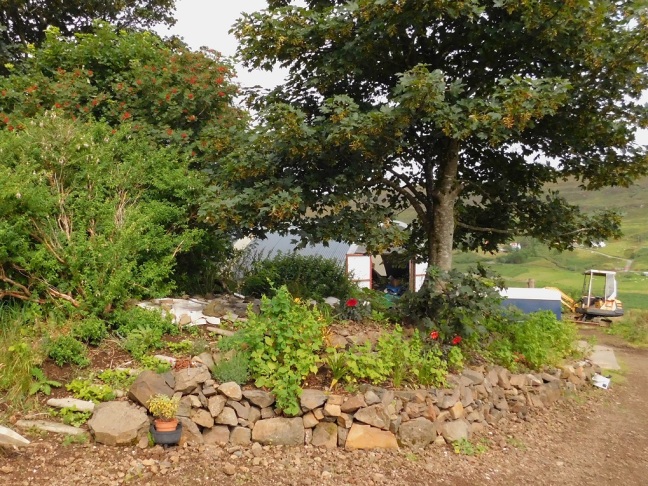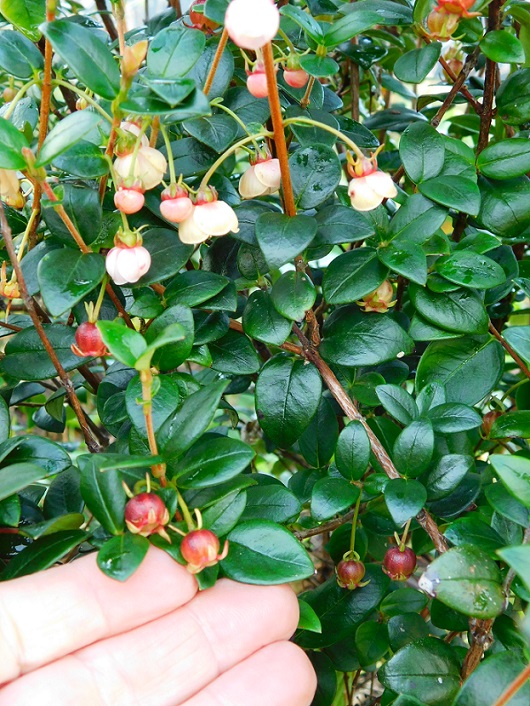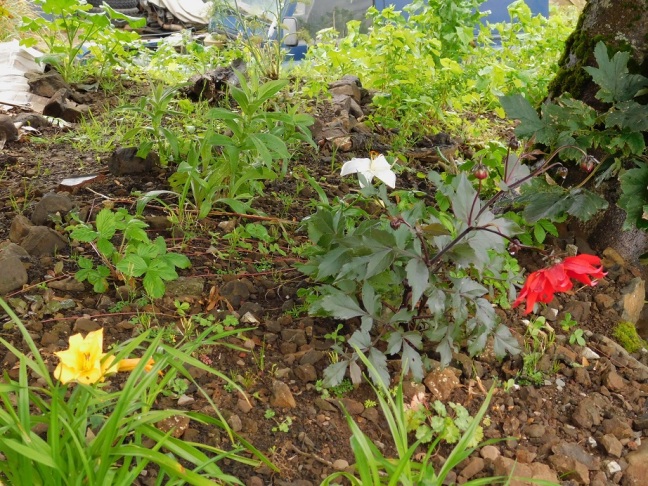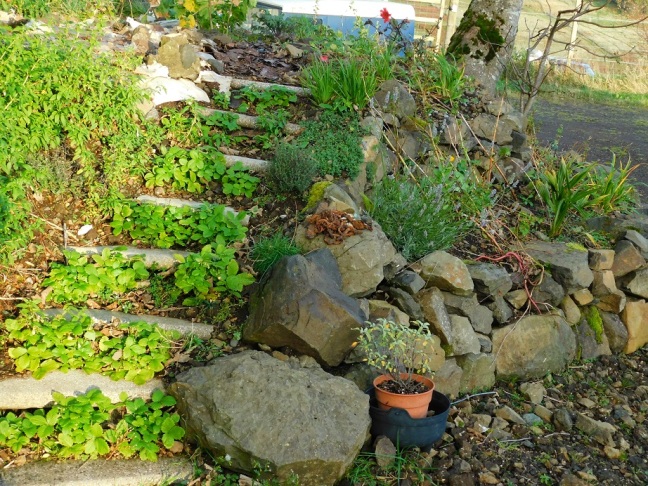
Well, I’m back safely. The drivebank planting is now approaching the end of it’s first season growth, so I thought I’d do an update on how it is getting on. Generally I’m pretty pleased. I think most of the perennial plants have at least established OK. I lost the Philadelphus, thanks to Dougie (bless him!) using it as a toy and pulling it out and chewing it, but the other shrubs seem OK. The Elaeagnus look a bit bare – I think they lost a few leaves in the wind, which is a bit disappointing. I thought they would be reasonably wind resistant. The Escallonia of course is looking lush, and the Gaultheria is also doing well – just flowering and with small berries at the moment. I have quite a few babies of this that came from cuttings I took back in the spring which are doing quite well too. The variegated laurel, like the Elaeagnus, has lost a few leaves, but otherwise seems OK. I’ve poked in a few cuttings from one of my murtillo (Myrtus Ugni) in the hope that a slightly warmer spot may incline it to ripen fruit. The bushes in the tea garden grow and flower well, but the fruit never seems to come to much, and I’d really like to try making jelly with this! The fruit smell divine and taste like sherbert strawberries, incredible! They are quite small and pippy though, so I think jelly will be more successful than jam.

At least one of the broom are doing very well, having put on quite a bit of growth this year. Fingers crossed it survives the damp winter ahead. I’m wondering whether to plant some of this down the hill in the patch with ash trees that don’t seem to be doing very well. It is a native plant (I’ve seen it growing on the island), the bees love the flowers, it is a nitrogen fixer and tolerates dry soil, so should be OK where the soil is a bit shallow there. Broom does in fact need it well drained, so won’t grow happily just anywhere here.
I was a bit disappointed with the lack of germination from the seeds I broadcast. I was hoping to get a bit more coverage and blooms from the Calendula, but there were only a few came up early on and then some stragglers at the tail end of the season. These are still blooming now, but rather sparse. They all seemed to be different colours and forms too, whereas I thought I was expecting just single orange flowers from the packet. There was more coverage from the unknown buckwheat, but these aren’t particularly colourful examples; I will leave the debris overwinter to protect the soil a little bit. There seem to be one or two of the other herby things I broadcast, I’m not sure whether they are chervil or caraway or coriander, a bit tiny to pick the leaves from. Maybe more will come up next year.
Initially I got quite a good coverage from the bittercress weed plants, which I just left to get on with it – they are too tiny to be a problem in my opinion. I do try and take out the buttercup, docken and nettle seedlings and the various grasses that seem to have come back either through missed roots, or seeds. The buttercups and docken are the worst, because the leaves come off, leaving the roots intact. Sometimes I left them, but generally I tried to lever them out, because chances are they will regrow. I pulled the leaves off the weeds and scattered them on the soil to create a bit of mulch, although this was pretty ineffective – actually the weeds were much less prolific than I was expecting, although I don’t suppose I have seen the last of them! In fact, the bittercress seem to be making a second coming now in the cool of the autumn.

A few things I planted to climb and/or spread, all of which are pretty tiny still. I seem to have mixed up the Lathyrus linifolius and Lathyrus tuberosa when planting them. I don’t expect this will matter too much, although the L. tuberosa should become a much taller plant, so may (hopefully?) be a bit much where I was expecting the smaller L. linifolius to be growing. The Akebia again is very tiny, but is alive and looks healthy enough. Hopefully it will survive the winter and do better year on year, to climb the sycamore. The wild strawberry I planted at the top under the tree, is spreading enthusiastically. I think this is supposed to be a better fruiting form that I bought from someone (I can’t remember where now). No fruit yet, but maybe next year….

All the perennial herbs have established well. The little oregano plant was a mass of blooms which the bees really appreciated earlier in the year. Again, it seems to be having a second wind with another batch of flowers now. The marjorum (unknown) from the polytunnel has been fine. The lavender bloomed quite late. This is a pity in a way, because it leaves it too late to take cuttings after it has bloomed. I will have to take a few in the spring, and hope that I still get the flowers. These are on tall stems, and I think the plant has the potential to get a bit big. It doesn’t matter too much if it overhangs the steps a bit. The sage also seems fine. I left the main plant in a pot, which I have brought in to the polytunnel to keep it drier over the winter. There were several smaller plants that I had grown from cuttings which I tucked in at the top of the main wall. These I hope will be well enough drained to overwinter outside OK. The chives as expected have been fine, they went in a bit late for flowers, but should look good next year. I may get some other clumping alliums to go with them, as they generally seem to do OK here. The little rosemary seems to be fine, and again at the top of the wall should be OK to overwinter.

I have been quite pleased with most of the perennials I planted out. The daylillies, which had never a flower in three years in the shop planters, have bloomed quite happily on and off this summer. Indeed they still seem to have buds coming now! The dahlia have bloomed quite well, with simple red daisies and dark foliage. Also from the shop planters are the tall lillies. These all seem to have white flowers, whereas the shorter ones left in the shop planters are yellow. This is not quite the mix I was expecting, but the shop flowers match my icecream flag nicely. The various campanula seem to be growing bigger now than they did in the summer, which is a bit unexpected. Maybe they would prefer somewhere a bit more shady. I did tuck some in by the pea wigwam in the front garden (which turned out too shady for peas) so they may do better there. All I can say for the asparagus and artichoke is that they seem to be alive still. Hopefully they are established enough to come back next year. There is no sign of the nerines, which should be in flower just now, so I may have lost those.
Slightly tender plants include the salt bush, Atriplex canescens, which I grew from seed. It still looks a bit small, but reasonably OK. The leaves make quite a nice salad leaf with a salty juicy crunch. The bush needs to get quite a bit bigger before it is useful for eating though! The little Trachycarpus is forming new leaves. This will be a slow growing plant I expect. There is one I donated to Glendale Estate house, Hamera lodge, when I didn’t realise the uses of it, which is still only about eighteen inches tall after 8 years or so. Admitedly they planted it in a rather shady spot I think, so it could have done better. I’ve just agreed to look after the gardens there as well (excepting the lawn mowing) which should be fun! It has a large walled garden, which has been virtually unmanaged for several decades, but has a few apple trees and a lot of potential.

I have been very pleased with my “strawberry steps”. I planted out some white alpine strawberry plants, which I had grown from saved seed (originally a James Wong seed grown plant). The white strawberries are supposed to be less likely to be taken by birds, but still have a lovely sweet strawberry taste when properly ripe – they go suddenly bigger and paler, but it can be a subtle change. These have bulked out nicely and ripened some fruit. Next year they should do even better, and give a nice coverage to the steps. Since the steps are a bit narrow, being made of curb stones I had dug up from the pedestrian gate path, it is a bit difficult not to step on the strawberries when ascending the steps. Some of the sedum seeds I sowed there have also germinated. I’ll have to decide whether to transplant those, or to leave them in situ.
All in all a pretty good first season. My task next year is to finish off the wall around the corner by the barn, with more steps or a ramp for access there, and maybe continue above the steps to the pathway by the willow fedge.





Glad you got home ok, hope your plants survived the journey too x
LikeLike
All home, all fine, thanks. I’ve already planted most of them!
LikeLike
Lovely picture of the bee on the oregano.
LikeLiked by 1 person
Thanks. They were so happy! It was a cushion of flowers.
LikeLike
Looking great! Always plenty to keep you busy and creative. It is spring or fall there?
LikeLiked by 1 person
We’re in autumn (fall) now. Just starting to get a few frosts. Maybe snow showers this weekend.
LikeLike
Same here.
LikeLiked by 1 person
The drivebank is coming along nicely. Weird all the different calendulas from the same seed.
LikeLike
Thanks. I’m pretty pleased it didn’t just go to weeds (which if I’m honest is what I was expecting!) Yes, I don’t suppose it matters, but I was expecting all the calendula to be the same. I don’t think it has set seed though.
LikeLike
Shame if the calendula have not set seed. I don’t like the smell of the flowers too much but they are probably in the garden for life now!
LikeLiked by 1 person
They do make a nice splash of colour, without taking over.
LikeLike
😊
LikeLike
I have had that, too. The flowers were all the same colour when first down but their offspring are yellows through to orange.
LikeLiked by 1 person